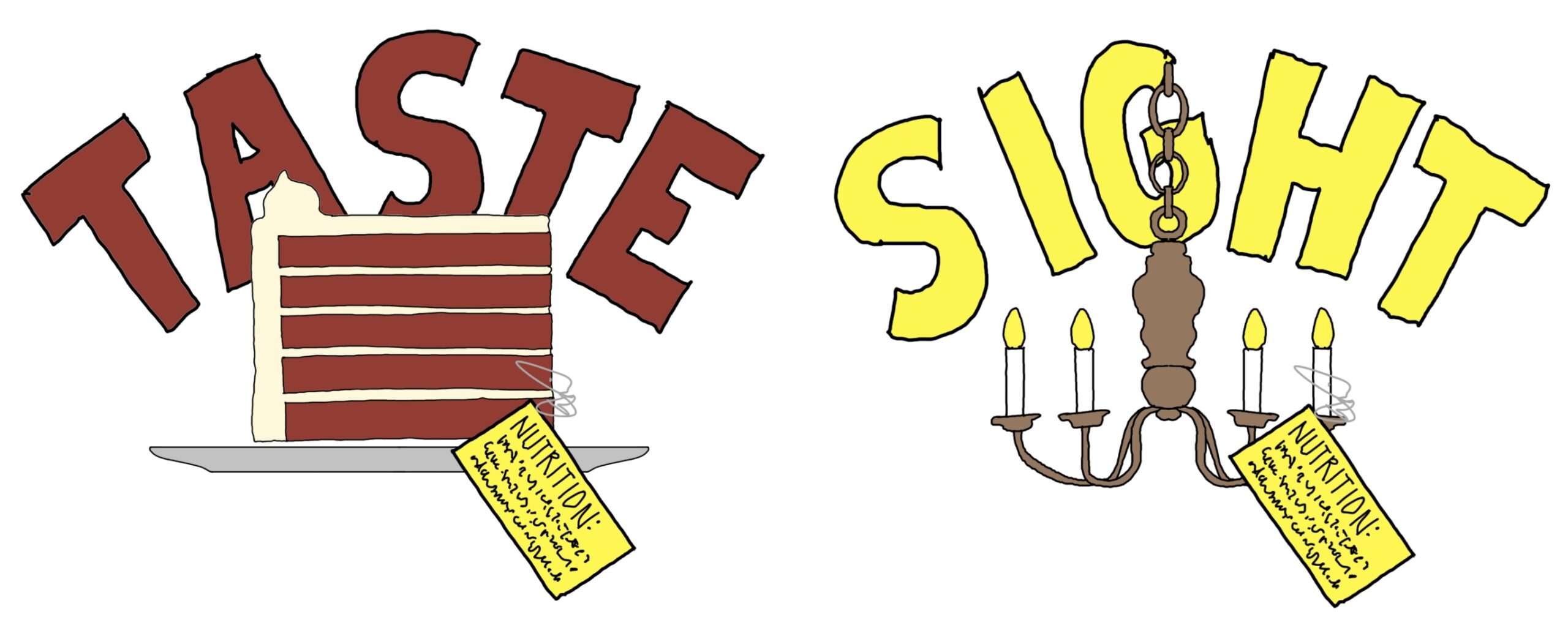Light for our bodies can help us feel better, and this may be the most important promise of them all.
Throughout human history, discovery and invention have joined together to deliver turning points of epic proportions, moments at which all of humanity advanced into new eras.
We discovered countless galaxies and nebulae and expanded our knowledge of the heavens, but only after the invention of the telescope. We discovered viruses and their cures, but only after the perfection of the microscope.
We countered near-sightedness after the invention of eyeglasses. We healed the sick when sterilization and blood transfusions made surgeries safer. We connected the world with telegraphs and telephones. We traveled the world with steamships and airplanes.
And yes, we conquered darkness when we invented the lightbulb. But this post is about the next turning point in the story of humanity and light. Today we are slowly but inevitably leaving behind an era that will someday be defined as “those primitive years when all we had was steady, white light.”
Light and its effects on our health and wellness is a subject far greater than a blog post or two could cover. There are talented, dedicated researchers spending their entire professional careers exploring how light impacts our brains and bodies. There are countless research projects and entire symposiums dedicated to understanding how our daily intake of light affects our endocrine functions, our sleep, our memory, and so much more. Our body of knowledge for light and our bodies has exploded over the past two decades the way our understanding of the universe expanded with the telescope.
This blog is not a deep dive into the science. I am simply ill-equipped to explain the discovery of iPRGC’s (intrinsically photoreceptive retinal ganglion cells) and their impact on our biorhythms through our SCN (suprachiasmatic nucleus), or any other of the hundreds of important biological impacts of light. Assuming the extreme risk of oversimplification, I only endeavor to make the basic level of the concepts accessible. Light (for our bodies) can help us feel better, and I call this the third promise of light.
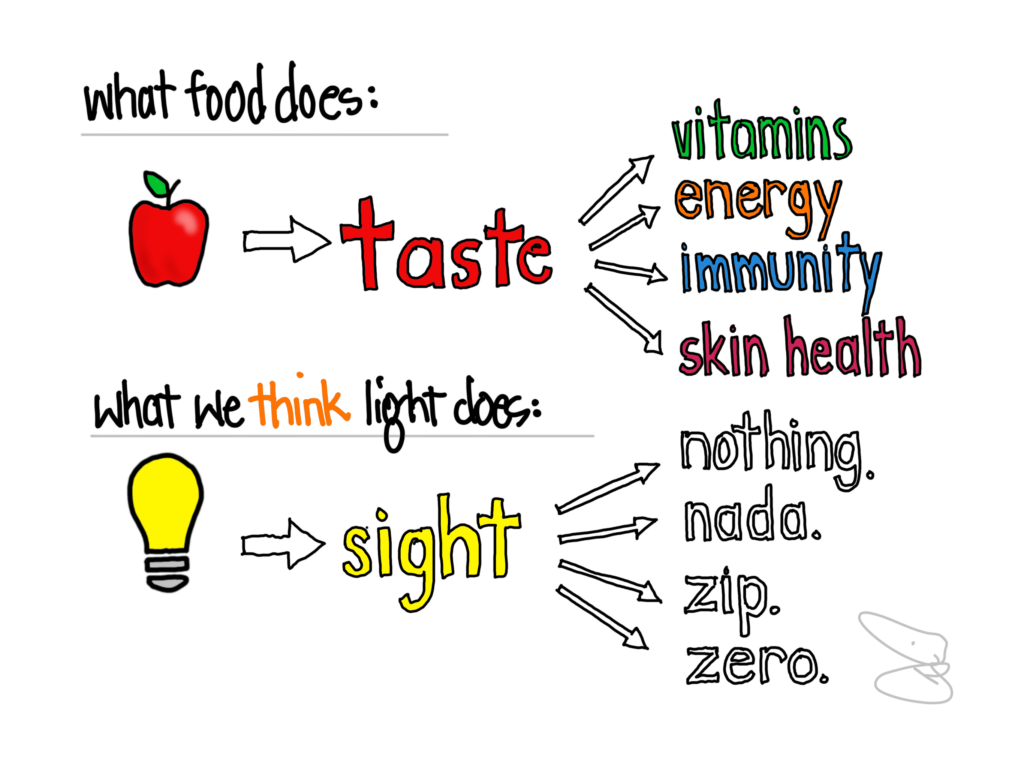
Let me draw a parallel to another aspect of human wellness that we, as a society, know better than light. Food is a major component of our daily existence. We value its taste quite highly, but many of us also have at least a basic understanding that food is much more important than the momentary pleasure we receive when it crosses our tastebuds.
We know that food, after the taste sensation has faded, is broken down into nutrients essential for our survival. We know that some foods are “empty calories,” perhaps tasting good but not providing the vitamins and minerals and other goodies our bodies need to be healthy. We know that other foods are crammed with these essentials, even labeling them superfoods not for their taste but for how good we feel afterwards.
For most of my life, I thought of light like I think of Red Velvet cake: tasty, but not something that will keep me healthy. Or, in lighting terms, beautiful, but not something that will affect my health.
I was wrong.
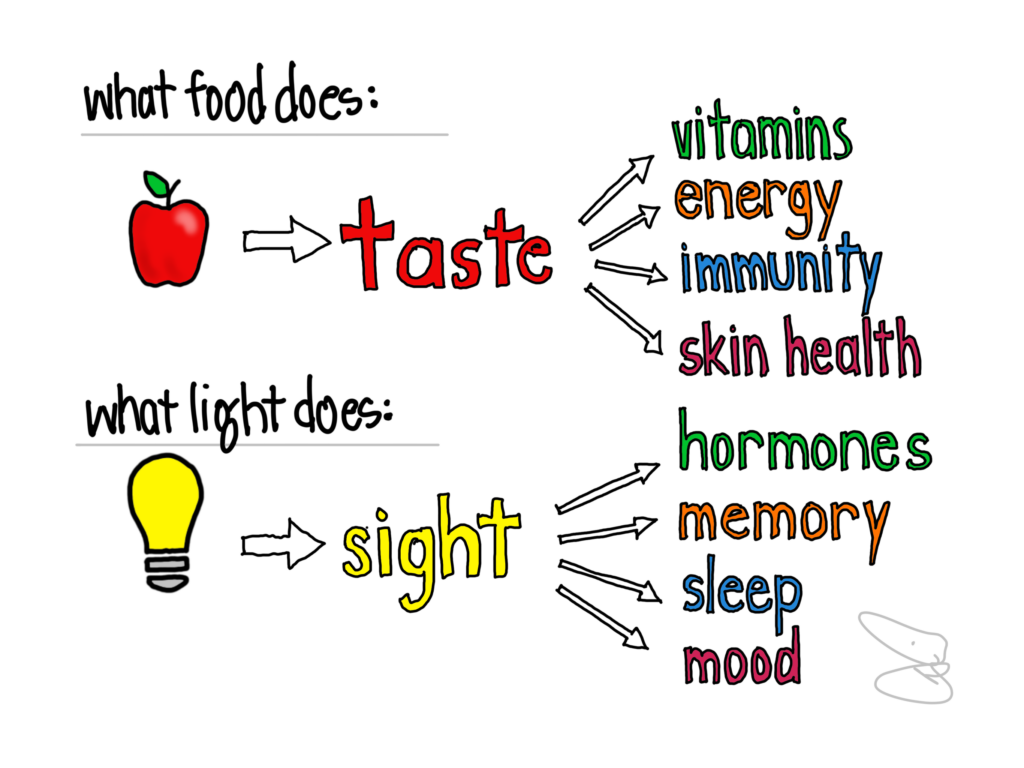
Scientific advancements of the past few decades have taught us much more about how light affects our bodies. Sure, sight is important, as is beauty. But those are just the instant emotional impacts of light, like the instant pleasure of a bite of cake. Much more subtle and hidden are the aspects of light that affect our hormones, our memory, our sleep, our mood, and so much more. Yes, there is something analogous to nutrition in the photons consumed by our eyes, every day.
To summarize my current understanding of light and health, which admittedly seems to expand regularly upon reading another study, consider light as a superfood. When used artistically, light can bring instant pleasure. When used scientifically, light can bring lasting health.
Much of the impacts of light on our health and wellbeing are felt through our sleep cycle. Circadian rhythm is a fancy term that describes our tendency to wake with sunrise and sleep after sunset. Hidden within our daily rhythms are a host of bodily functions (yes, including bowel movement timing) that are “scheduled” primarily by our intake of light. If we get the right light at the right time, in other words, our bodies will do the right thing at the right time.
If we do not get the right light at the right time, our bodies will struggle. First we will use caffeine to wake up or stay alert, then we will use melatonin or alcohol or other substances to relax. We will be forced to supplement our light nutrition with drugs of one kind or another.
After these initial effects our bodies will suffer long term consequences. One study pointed out that people who sleep with some light in their room do so with elevated blood pressure than those who sleep in darkness. Other studies show how memory and cognition are improved with circadian entrainment through better lighting. Most heart attacks happen in sync with our circadian cycle. Most addictions start as adolescents when our school days force us out of our natural rhythms and leave us craving.
I could go on and on for post after post, and likely will return to this subject again and again (read more posts on light and health HERE). But let me summarize it all this way:
An apple a day keeps the doctor away. Thirty apples a day will put you in the emergency room.
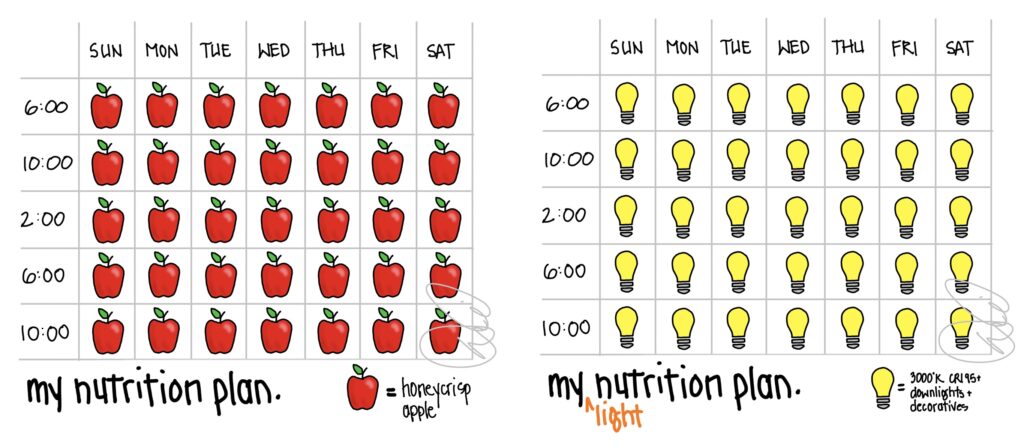
When we look at the nutrition plan above, it does not take much more than a third grade science or health class to realize that relying on a single food for all your nutrition, day in and day out, will lead to some pretty bad results. We were taught that sailors got scurvy when they omitted certain nutrients. We know that eating fast food every day for every meal will do more than make us obese; it will make us sick. Our governments develop guidelines in the shape of food pyramids or plates or recommended daily allowances. The bottom line is that we need many different nutrients and must consume the right foods to gain them.
Light is similar. We now know – after more than a century of consuming white bread, er, white light – that we need a diet of whole-grain lighting and fruits and vegetables. We need the right kinds of light, the right wavelengths, at the right time of day. We need to consume the right quantities, but most of us still consume one kind of white light, in one amount, all day.
Does the electric light in your indoor workplace change over the course of the day? Are the lights in your living room different at 7pm than at 11am? If not, you’re eating apples for every meal, and you won’t be living the healthiest of lives.
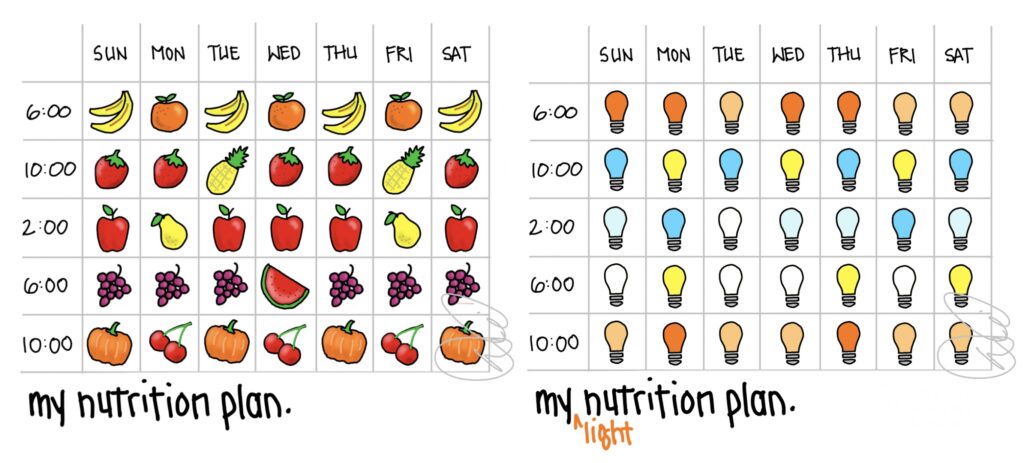
Your nutrition plan likely goes beyond simply how your food tastes. I like red velvet cake more than I like broccoli, but I eat a lot more broccoli than cake. I learned to like kale and brussel sprouts and whole grain breads. I limit my consumption of sugary soda drinks and consume more water. I try to consume a healthier diet because I know it is good for me (and can taste wonderful, too). I still have a long way to go…there is something about a plate of cookies that turns me into a toddler wanting more. But I know better.
Now I’m learning to like bright whites in the morning and warm whites in the evening. I’m limiting my consumption of light before bedtime. I’m typing this on my deck because I’ll feel better if I spend some of my morning outside. I still like beautiful light, light that is just plain fun and delivers no health benefits. But I know better.
Light for my body helps me feel more alert and creative in the morning. Light for my body helps me feel more relaxed in the evening. Light for my body helps me feel better all day long.
Light helps me live better.
Stay tuned. My next post in the Light Can Help Us series will explore a few practical applications of the science and biology of light.
Read past posts that touch on light and health HERE.
